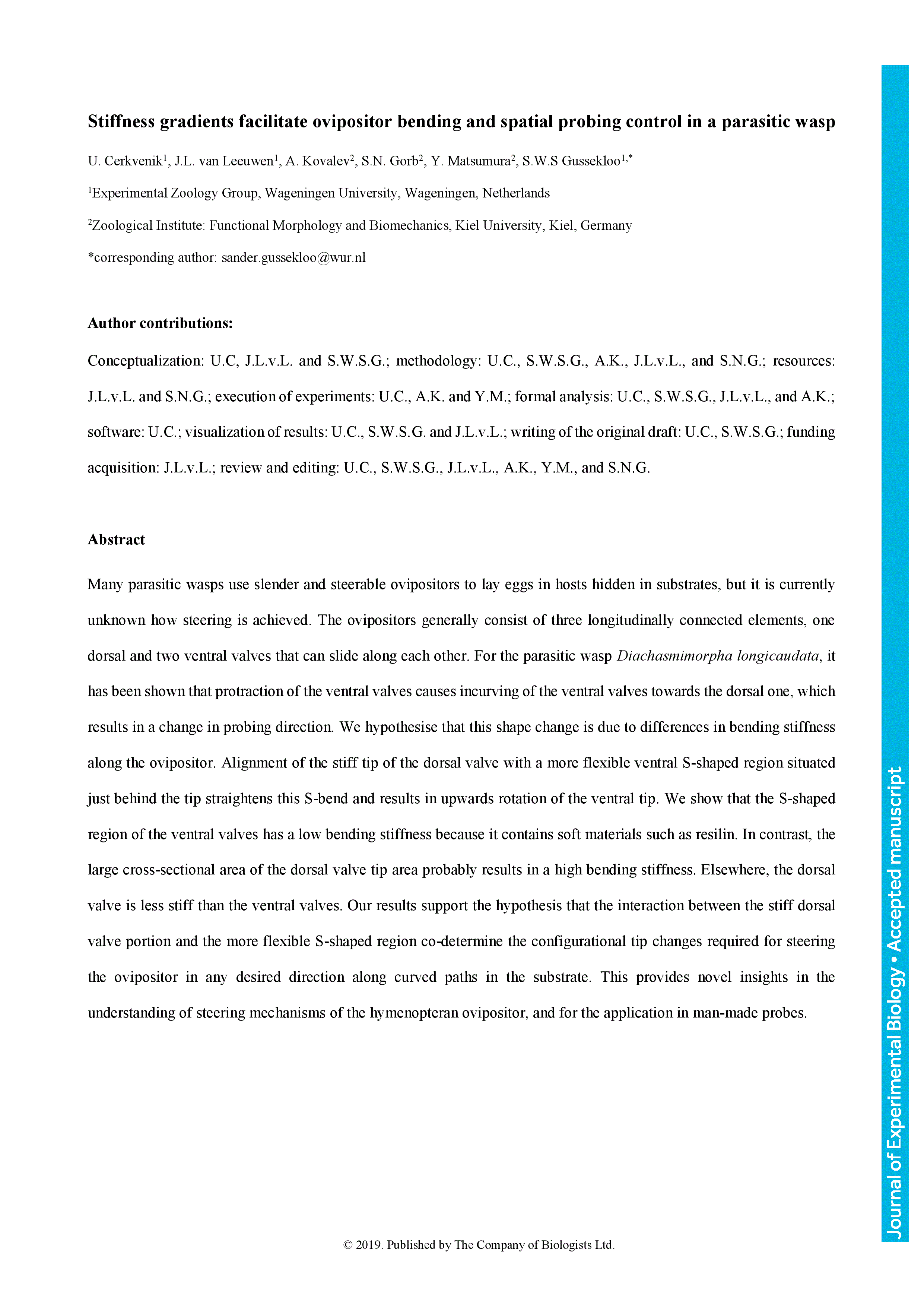Many parasitic wasps use slender and steerable ovipositors to lay eggs in hosts hidden in substrates, but it is currently unknown how steering is achieved. The ovipositors generally consist of three longitudinally connected elements, one dorsal and two ventral valves that can slide along each other. For the parasitic wasp Diachasmimorpha longicaudata, it has been shown that protraction of the ventral valves causes incurving of the ventral valves towards the dorsal one, which results in a change in probing direction. We hypothesise that this shape change is due to differences in bending stiffness along the ovipositor. Alignment of the stiff tip of the dorsal valve with a more flexible ventral S-shaped region situated just behind the tip straightens this S-bend and results in upwards rotation of the ventral tip. We show that the S-shaped region of the ventral valves has a low bending stiffness because it contains soft materials such as resilin. In contrast, the large cross-sectional area of the dorsal valve tip area probably results in a high bending stiffness. Elsewhere, the dorsal valve is less stiff than the ventral valves. Our results support the hypothesis that the interaction between the stiff dorsal valve portion and the more flexible S-shaped region co-determine the configurational tip changes required for steering the ovipositor in any desired direction along curved paths in the substrate. This provides novel insights in the understanding of steering mechanisms of the hymenopteran ovipositor, and for the application in man-made probes.
ACCEPTED MANUSCRIPT
RESEARCH ARTICLE|
01 January 2019
Stiffness gradients facilitate ovipositor bending and spatial probing control in a parasitic wasp
U. Cerkvenik
,
U. Cerkvenik
1
Experimental Zoology Group, Wageningen University, Wageningen, Netherlands
Search for other works by this author on:
J.L. van Leeuwen,
J.L. van Leeuwen
1
Experimental Zoology Group, Wageningen University, Wageningen, Netherlands
Search for other works by this author on:
A. Kovalev
,
A. Kovalev
2
Zoological Institute: Functional Morphology and Biomechanics, Kiel University, Kiel, Germany
Search for other works by this author on:
S. N. Gorb
,
S. N. Gorb
2
Zoological Institute: Functional Morphology and Biomechanics, Kiel University, Kiel, Germany
Search for other works by this author on:
Y. Matsumura
,
Y. Matsumura
2
Zoological Institute: Functional Morphology and Biomechanics, Kiel University, Kiel, Germany
Search for other works by this author on:
S. W. S Gussekloo
S. W. S Gussekloo
*
1
Experimental Zoology Group, Wageningen University, Wageningen, Netherlands
*Author for correspondence: sander.gussekloo@wur.nl
Search for other works by this author on:
U. Cerkvenik
1
Experimental Zoology Group, Wageningen University, Wageningen, Netherlands
J.L. van Leeuwen
1
Experimental Zoology Group, Wageningen University, Wageningen, Netherlands
A. Kovalev
2
Zoological Institute: Functional Morphology and Biomechanics, Kiel University, Kiel, Germany
S. N. Gorb
2
Zoological Institute: Functional Morphology and Biomechanics, Kiel University, Kiel, Germany
Y. Matsumura
2
Zoological Institute: Functional Morphology and Biomechanics, Kiel University, Kiel, Germany
S. W. S Gussekloo
*
1
Experimental Zoology Group, Wageningen University, Wageningen, Netherlands
*Author for correspondence: sander.gussekloo@wur.nl
Received:
16 Nov 2018
Accepted:
31 Mar 2019
Online ISSN: 1477-9145
Print ISSN: 0022-0949
Funding
Nederlandse Organisatie voor Wetenschappelijk Onderzoek
(NWO-VENI-863-14-007)
J Exp Biol jeb.195628.
Article history
Received:
16 Nov 2018
Accepted:
31 Mar 2019
Currently Viewing Accepted Manuscript - Newer Version Available
02 May 2019
Citation
U. Cerkvenik, J.L. van Leeuwen, A. Kovalev, S. N. Gorb, Y. Matsumura, S. W. S Gussekloo; Stiffness gradients facilitate ovipositor bending and spatial probing control in a parasitic wasp. J Exp Biol 2019; jeb.195628. doi: https://doi.org/10.1242/jeb.195628
Download citation file:








